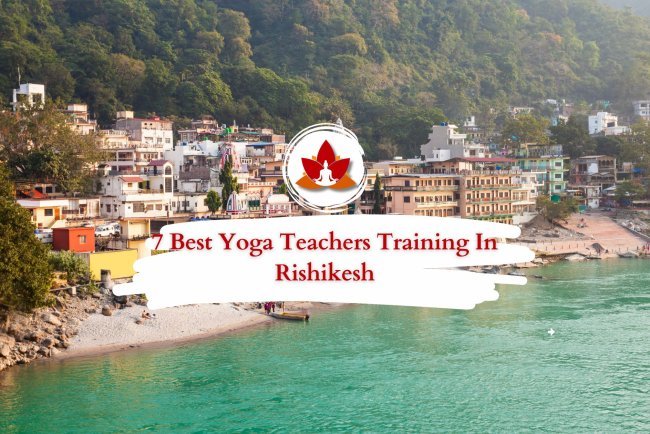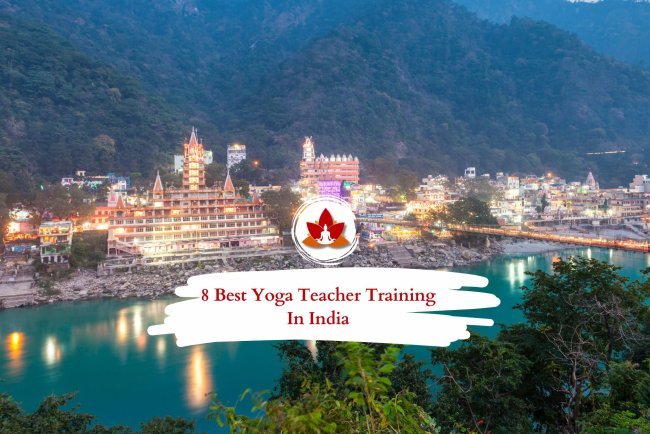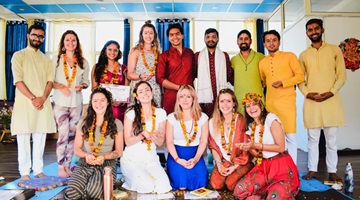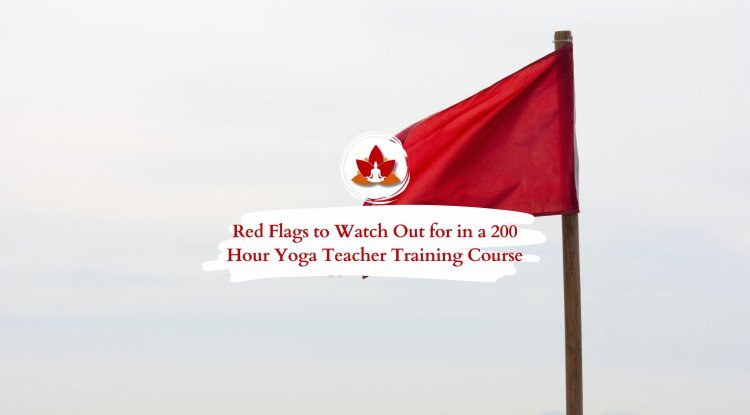8 Red Flags to Watch Out for in a 200 Hour Yoga Teacher Training
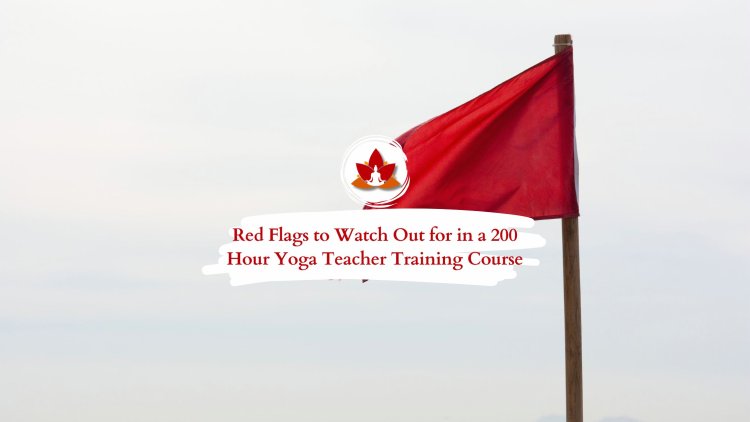
Before finally deciding to invest your time in a 200 Hour Yoga Teacher Training , one needs to note that this path is way much more than just being an instructor for yoga classes. A high-quality program like this should be a sacred space where one learns to dive deeper into their practice and develop a deep understanding of themselves in order to unleash one's full potential.
With a good number of yoga teacher training across the globe, the task becomes quite difficult with respect to differentiating between courses that are top-notch and those that only sound good on paper.
How to Spot the Red Flags in 200 Hour Yoga Teacher Training
Otherwise, with inadequate training and expertise, you can end up with a certificate that is relatively useless. If you don't do your research, you're going to waste a lot of money and time on a class that isn't equipping you to teach yoga safely and effectively.
Here are the top 13 red flags to watch out for when choosing a yoga certification course, so you can avoid that happening.
1. Not Registered with Yoga Alliance USA
When it comes to choosing a yoga teacher training program, one question in your mind might be: Is it important for the program to be registered with the Yoga Alliance? For a more clear picture on this : it really doesn't assure much in regard to the quality of the program. Any school can apply online, and nine times out of ten, they are registered.
Recently, however, Yoga Alliance has begun to institute more rigorous standards of practice; therefore, registered schools and trainers have to meet stricter requirements. There has been a shift to ensure that there is a degree of quality and transparency in the education of yoga.
Those who are eying a registered yoga school will have all the benefits that come with being able to view the curriculum, reading through the feedback of students, and checking through the qualification of trainers. The unregistered schools offer limited transparency and your major sources of information will be the website of the school and their social media—both of which can at times be quite subjective.
2. Less Personal Attention Due to Large Group Size
With the number of yoga practitioners reaching 350 million by the end of the decade, the demand for quality yoga teacher training programs has increased. Drawing from my 10 years of experience leading 200 hour yoga teacher training, I find the ideal group size, whereby a meaningful learning experience can be derived, would be between 15-20 students.
When yoga classes exceed 20 students, personal attention from the teacher automatically diminishes. Less opportunity for one-to-one interaction, time to ask questions, and thus less chance of airing one's view or ensuring that the subtleties of the practice of yoga are fully understood.
3. No Yoga Philosophy, Lifestyle and Ethics Lessons for Yoga Teachers
If you are a keen aspirant who wants to teach yoga, at least 20 hours of your training program should be focused on the key subjects mentioned below:
-
Yoga Philosophy
-
Lifestyle Lessons
-
Ethics
If these and some other core subjects are not taken into consideration, then a teacher training course can never have the real sense and purpose behind teaching yoga. In case you don't have solid base know-how in the origins and the ethical principles of yoga, you may simply lack that important context that is required for safe, ethical, and truly enriching instructions.
Yoga Philosophy, Lifestyle and Ethics form the bedrock of yoga teaching. Therefore, it is essential that at least the first two limbs of yoga—Yamas and Niyamas—have an emphasis on yogic philosophy and how it is to be applied in everyday life, off the mat. Hence, an internationally accredited organization like Yoga Alliance USA stipulates that there needs to be a minimum of 20 contact hours for Yoga Philosophy in the 200 Hour Yoga Teacher Training .
Hence, in the light of this standard, I would seriously question the credibility of any 200 hour Yoga Teacher Training lacking a comprehensive Yoga Philosophy curriculum.
4. Very Short Duration
It is only reasonable to spend at least 22 to 24 days to finish a yoga teacher training course consisting of 200 hours. According to Yoga Alliance standards, the average 200 hour program is supposed to incorporate 185 contact hours in person or online and another 15 non-contact hours in reading assignments and practicum. This will thus ensure that most of your training is in real time with your instructors so you get feedback and questions answered.
When the training duration is less than 22 days—like programs crammed into a mere 14 days—the necessary hours cannot be obtained without days that are unacceptably long. This can be exhausting, both physically and mentally, which makes it difficult to absorb and retain information for becoming an effective yoga teacher.
5. Poor Anatomy and Physiology Techniques
A proper Yoga Teacher Training Program should cover at least 10 hours of contact regarding Anatomy and Physiology. Out of these, a minimum of five hours should be devoted to important learning objectives like the following:
-
Human and Energy Anatomy
-
Application to Yoga Practice
-
Benefits, Contraindications, and Healthy Movement Patterns
In view of this, it is simply not feasible to attempt to teach without these very basic lessons in anatomy and physiology in teacher training. Knowing muscles, joints, and body mechanics is crucial for proper alignment, modifications, and injury prevention. Unless supported by a strong scientific understanding of the aforementioned fields, instructors can unconsciously lead students into dangerous practices that might result in possible harm.
6. Poorly trained instructors
While too many trainers could be a problem, the opposite—a lead trainer without a backup team—is an enormous red flag in a 200 hour yoga teacher training, particularly in places like Bali. There is no experienced trainer able to manage the needs of the whole program all by himself. At a minimum, a good training would include at least 3 to 4 trainers so that there can be a balance in the learning environment.
Teaching without this support staff can lead to the lead instructor getting exhausted quickly, which in turn diminishes the quality of instruction. Moreover, a single instructor cannot offer the personal touch that students need, especially larger groups. With multiple instructors, the responsibilities become divided, providing less burden on the lead instructor and greater focus on personalized instructions.
7.Too many yoga styles offered in the curriculum
In some yoga schools, five to six different styles of yoga are taught, which really can resemble something of a "yoga buffet." This may burden students with too much information and lead to shallow teaching. Complementary styles like Vinyasa and Yin yoga can offer knowledge and tools of great value when conducted correctly, but an attempt to address too many styles in only 200 hours of a YTT usually lacks depth.
While teacher training programs that offer a wide variety of yoga styles may sound very interesting, in reality, within the framework of 200 hours, there is not much time to delve into each style. Quite frankly, this yogic path is one of patience and self-discipline. So, it is good to have an introduction, but more effective to seek out an expert in the style you are interested in during your 200 hour YTT. This will provide you with the opportunity to deepen your understanding of the subject matter and distinguish yourself as a highly qualified teacher within that style.
8. Fewer User Reviews
If a yoga school has very few reviews or testimonials, this could be due to the fact that it is very new and may not have had the chance to train many students yet, or it possibly hasn't had any feedback that would be strong enough to share publicly. Some negative reviews don't really have to be a red flag; on the other hand, this might prove a degree of honesty and transparency issued by the school itself.
Attention: The fact that there are plenty of rave reviews doesn't guarantee the high quality of a school either. Now, for an unfiltered view, your best resource would be Google and then Trustpilot Yoga Alliance, the "TripAdvisor" of the yoga world. You will be able to read transparent reviews of different schools here and can make your own judgment based on your standards.
Conclusion:
Becoming a yoga teacher is one of the most transformational experiences you can embark on. Ultimately, however, choosing the right school for you is very critical in your journey. Be careful while deciding on the program that will set you on a right path toward your goals and values. Further down the road, after graduation, continue raising your practice through self-directed learning, helping other teachers, and finally perfecting your sequencing skills. Continuous pursuit of growth will ensure that you teach not only yoga but live it out in every other aspect of your life.
What's Your Reaction?







